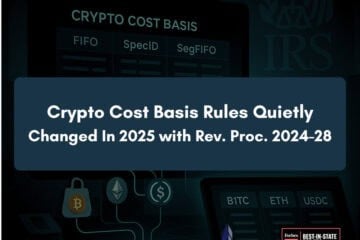Last Updated on September 25, 2025 by Patrick Camuso, CPA
If you’re still relying on 2020-era structures or DIY tax logic, especially after attending Bitcoin Vegas 2025, this is your wake-up call.
The panels are over. The booths are packed up. But the compliance gaps I saw in Las Vegas, Nevada at Bitcoin Vegas 2025? They’re still wide open and most investors, founders, miners and fund managers don’t even realize it.
I sat across from a miner clearing over $20M last year who didn’t even know he defaulted into FIFO. One founder I spoke to at the Bitcoin Vegas 2025 was using Specific ID without ever filing the proper election. He was on the hook for $880K in phantom gains. That’s what we’re still dealing with, as many people are unaware of their shortcomings .
More than 35,000 crypto-native builders, investors, and thought leaders converged at The Venetian for what was arguably the most politically charged and economically significant bitcoin conference in history. While the mainstream coverage highlighted high-profile speeches and bullish sentiment, very few are addressing the urgent and mostly hidden compliance risks and tax planning gaps still undermining this entire community.
I was there to extract signal, diagnose structural vulnerabilities, and deliver clear, actionable frameworks to help high-stakes operators protect their capital, scale defensibly, and avoid becoming the next headline audit case.
Who This Briefing Is For:
- High-net crypto investors holding $1M+ in digital assets
- Founders raising capital or issuing tokens
- Miners, OTC desks, and allocators scaling operations
- Corporations adding BTC and stablecoins to their balance sheet and payments
- Web3 CFOs managing treasury or fund structures
The Macro Shift: Pro-Crypto Policy Doesn’t Eliminate Regulatory Risk in the New Era

The political tone of Bitcoin Vegas 2025 was impossible to ignore. The Trump administration is now openly embracing crypto as a pillar of U.S. economic strategy, showcasing its leadership in this evolving landscape . The mood in Crypto Vegas 2025 reflected a dramatic policy shift from the enforcement-heavy posture of the past few years to a new chapter marked by proactive institutional support.
Vice President JD Vance’s keynote reinforced this realignment. His remarks spotlighted a regulatory agenda designed to cement American leadership in digital assets, from repealing SAB 121 to halting the CBDC agenda, and from ending Operation Chokepoint 2.0 to launching a Strategic Bitcoin Reserve. Each of these actions signals a clear departure from the antagonistic stance of past regulatory regimes.
The GENIUS Act, central to Vance’s address, proposes a comprehensive framework for regulating stablecoins, one that positions fiat-backed digital currencies as an extension of U.S. monetary power rather than a threat. As Vance put it, “Stablecoins aren’t a threat to the dollar, they’re a force multiplier of our economic might.”
But none of this optimism should be mistaken for immunity. Institutionalization brings enforcement, not amnesty. More regulatory clarity means less room for error and fewer excuses. The IRS is modernizing their surveillance and audit capabilities to match this new wave of legitimacy. The question isn’t whether enforcement is coming for cryptocurrency enthusiasts . It’s whether your tax structure is ready for it.
The political winds may now be at crypto’s back. But that bullish tone doesn’t mean a free pass. And structurally, most investors and operators are still exposed to risks rooted in yesterday’s frameworks. And in 2025, that’s no longer sustainable.
Many founders and investors have misread the current momentum. Political tailwinds, no matter how favorable, do not translate to tax immunity. Just because regulatory bodies are signaling support doesn’t mean they’re standing down. In fact, the IRS is rapidly modernizing its audit and enforcement mechanisms, particularly for digital assets. The obligation to demonstrate compliance still falls entirely on you, not on the government to prove noncompliance. For assistance, feel free to contact us Waiting to plan, in this environment, often means locking in overpayments, missed elections, or worse, audit exposure.
The narrative has changed. Your tax structure needs to evolve with it.
Field Intelligence: The Structural Tax Problems Still Plaguing Crypto Investors and Operators

During Bitcoin Vegas 2025, I spoke with dozens of serious operators, founders of token networks, Bitcoin miners, retirement funds, OTC desks executing high-volume trades, and fund managers actively deploying capital into BTC and ETH. These weren’t surface-level conversations. They exposed critical structural flaws still undermining the financial systems of even the most experienced players.
The first and most frequent issue I uncovered was the failure to formally elect an accounting method, resulting in a default to FIFO and significant, unnecessary overpayment of taxes. This alone is costing operators six to seven figures annually. But the problems didn’t stop there. Many founders and funds are still running wallet infrastructures that have no alignment with their legal entities or cost basis, leaving them vulnerable to reclassification, audit complications, overpayment in taxes and breakdowns in defensibility. Flow-of-funds control was another weak point, no strategy realted to cost basis and tax lots and personal wallets were often being used for business transactions, and vice versa, making audit trails murky and opening the door for regulatory penalties.
Despite the widespread awareness of Rev. Proc. 2024-28, the vast majority had not adopted a defensible framework under it. Some are still operating entire token ecosystems through single-member LLCs or disregarded entities, structures that are fundamentally mismatched to the scale and complexity of their operations. Estate planning was virtually nonexistent in most conversations, and tax optimization at the portfolio or protocol level was rarely addressed with intent.
These are not early-stage oversights. They are institutional-level failures in architecture, systems, and strategic design. What became clear in Bitcoin Vegas 2025 is that the stakes are higher, the risks are more visible, and most operators are still behind. The patterns I pick up at events like Bitcoin Vegas 2025 turn into six-figure tax protection later. Field intel beats theoretical planning every time.
New Triggers: Rev. Proc. 2024-28 + 1099-DA = The New Enforcement Wave
Rev. Proc. 2024-28 went into effect last year, yet most investors and CPAs still aren’t applying it correctly.
What it governs:
- Accounting method elections (FIFO or Specific ID)
- Cost basis tracking expectations
- Wallet-level segregation
- Entity vs personal holdings
If you haven’t formally elected a method under this Rev. Proc., you’re defaulting into FIFO and potentially overpaying massively on taxes. Add to that the IRS’s upcoming 1099-DA mandate, and enforcement is no longer theoretical. It’s baked into the data pipeline.
The IRS has already prosecuted investors for failing to fully report crypto capital gains even without offshore accounts or intentional laundering. With 1099-DA enforcement and wallet surveillance expanding, these cases are only becoming more common.
At Camuso CPA, we receive dozens of inquiries each week from investors, miners, and founders who have received IRS tax notices related to undisclosed crypto transactions. The enforcement is real, and it’s accelerating.
Even many crypto-focused accountants haven’t fully adopted Rev. Proc. 2024-28, don’t structure multi-wallet reconciliations, and are missing entity alignment that matters for IRS defensibility. At Camuso CPA, we don’t just file we architect tax infrastructure for scale, audits, and capital preservation.
One critical tax planning strategy we implement for clients involves segregating assets by tax lots and cost basis across wallets and exchanges. We also strategically design wallet architecture and flow-of-funds planning to minimize capital gains, optimize entity usage, and create defensible audit trails. In an era of automated surveillance, your wallet structure is your first layer of tax protection.
Want a personalized audit of your crypto tax structure? Our Crypto Tax Health Check uncovers overpayment risks, missed elections, and audit exposure in less than 30 minutes.
Institutional Treasury Strategies Are Spreading—But Without the Structure
Michael Saylor’s firm, Strategy, now holds over 580,000 BTC, nearly 3% of the total supply. At Bitcoin Vegas 2025, he doubled down on this strategy of issuing debt, offering preferred shares, and buying Bitcoin on balance sheet.
Naturally, other founders, funds, and DAOs are now attempting to follow in his footsteps. But while many are quick to replicate the surface-level tactics, few are implementing the deeper compliance infrastructure required to sustain and defend this kind of balance sheet exposure.
The core issue is that you cannot copy the strategy without copying the structure. A treasury model like Saylor’s demands an entity framework built for digital asset custody, tax-efficient accumulation, and regulatory defensibility. Treasury governance must be explicitly documented and enforced across jurisdictions. Wallet flows need to be mapped not just to operational logic, but to precise tax reporting positions. And all of this requires close coordination between legal, accounting, and tax planning functions.
Without this spine in place, what looks like innovation is actually fragility. You may accumulate assets, but you’re also accumulating audit risk, tax inefficiency, and potential compliance liabilities. You’re building a treasury that’s not just under-optimized, it’s structurally exposed.
Bitcoin Vegas 2025: Don’t Copy Strategy Without…
- An entity structure capable of absorbing BTC with tax efficiency
- Treasury governance protocols across jurisdictions
- Flow-of-funds mapped to tax reporting logic
- Coordination between accounting, tax, and legal teams
Without this foundation? You’re building a treasury that’s audit-fragile and exit-inefficient.
The Camuso CPA Framework: 3 Non-Negotiables for 2025 Crypto Compliance
At Camuso CPA, we’ve developed a proven framework to help crypto investors and operators future-proof their tax posture, defend against audits, and unlock compounding tax efficiency in a rapidly evolving regulatory environment. Here are the three of the foundational pillars every serious crypto player must implement in 2025.
Accounting Method Election Under Rev. Proc. 2024-28
Defaulting to FIFO could cost you millions over time. Whether you’re optimizing for FIFO or Specific ID, your method must be formally elected and consistently applied across all wallets and exchanges. It must be documented, defensible, and implemented in accordance with IRS guidance. Anything less is an open invitation for reclassification or enforcement.
Wallet & Entity Structure Design
Your wallets must reflect your business model not just your convenience. That means segregating wallets by purpose: treasury, operations, smart contracts, investor funds, personal holdings, and even those in nashville . Each wallet should map to a compliant entity layer (LLC, C-Corp, LP), and flow-of-funds logic should align with your accounting system. Beyond this, we implement advanced planning by segregating assets by tax lot and cost basis, creating precise control over realized gains and losses in any market cycle.
Full Tax Stack Review
Your crypto tax profile isn’t just about what’s on-chain—it’s about what’s on paper. That includes entity formation, jurisdictional planning, income sourcing rules, audit trail integrity, and transaction-level reconciliations. We call this your “Digital Asset Tax Blueprint” for all attendees, and without reviewing it holistically, you’re likely paying more than you should, while simultaneously taking on more audit risk than you realize.
As we say at Camuso CPA: “This is how serious investors win the game: they design around tax, not react to it.”
The Cost of Delay: Why Catching Up Later Could Cost You Everything
At Bitcoin 2025 and at Camuso CPA every single week, we continue to see the same pattern of investors, founders, and operators who are still five to ten years behind on their crypto accounting and tax compliance. They’re running operations with no formal recordkeeping, no wallet reconciliation, and no entity structure. And they’re telling themselves they’ll “catch up later.”
But here’s the truth: there is no more “later.”
With 1099-DA reporting mandates taking effect and regulatory agencies leveraging real-time blockchain surveillance, the window for casually ignoring crypto compliance has closed. The IRS isn’t playing catch-up, they’re proactively targeting high-value wallets and unreported activity. And enforcement isn’t hypothetical anymore, we’re seeing it weekly in the form of tax notices, audit threats, and penalties issued to those who thought they had more time.
We receive dozens of inquiries every week from investors and operators who are now scrambling to clean up years of exposure. And while we help them get compliant, the reality is that the longer you wait, the worse the consequences and the more expensive the fix. Non-compliance is no longer an administrative oversight. In 2025, it’s a liability. It undermines your ability to raise capital, work with serious partners, and protect your wealth.
If you’re behind, now is the time to correct course, not in six months, not after the next bull run. The longer you delay, even from your family the harder it is to defend. And if you’re still operating like it’s 2017, you’re gambling with your future.
Why I Attend Bitcoin Vegas 2025 And What Camuso CPA Delivers Post-Event
Anyone can attend a Bitcoin conference. But not everyone extracts meaningful signal. At Camuso CPA, we show up to listen deeply, analyze patterns, and convert those insights into real infrastructure for our clients.
At Bitcoin Vegas 2025, I held dozens of one-on-one conversations with investors, builders, miners, fund managers, OTC desks, CPAs, CFOs and allocators, not in public panels, but behind the scenes where the real breakdowns get disclosed. We identified systemic compliance failures across eight-figure operations including gaps in wallet governance, misaligned entity structures, missing tax elections, and flawed assumptions about what enforcement really looks like in 2025.
We don’t just take notes, we turn intel into action. The insights we gather in the field become the foundation for upgraded tax strategies, custom entity frameworks, and defensible wallet architectures that withstand scrutiny and scale. These events are also a critical trust-building mechanism. Meeting our clients face-to-face, stress-testing their plans in real time, and delivering clarity amid chaos that’s how relationships compound and strategies sharpen.
Where This Is All Going: The Next 5 Years of Crypto Taxation
The takeaway isn’t just about retroactive cleanup, it’s about strategic positioning for the next five years of digital asset taxation. Most firms in the industry focus on filing. We focus on tax and accounting architecture.
At Camuso CPA, our clients aren’t reacting to regulation, they’re proactively designing structures that can withstand scrutiny, scale across jurisdictions, and minimize tax exposure. They’re engineering tax-smart wallet architectures, streamlining cross-entity asset flows, and planning ahead for token launches, liquidity events, treasury transitions, and fund exits. Their infrastructure isn’t improvised, it’s intentional.
They’re embedding tax defensibility directly into their tech stacks. They’re anticipating audit scenarios, mapping cost basis controls, and aligning operations with the latest IRS guidance, before it’s enforced. In this new regulatory cycle, you can’t afford to be passive. You can’t outsource responsibility. But you can delegate strategy, and that’s exactly what we deliver. Other crypto CPAs patch leaks. We engineer the entire tax infrastructure from the foundation up.
crypto CPAs patch leaks. We engineer the entire tax infrastructure from the foundation up
Where Camuso CPA Will Be Next: NFT NYC, Permissionless, and Bitcoin Vegas 2025, 2026
The mission doesn’t stop with Bitcoin Vegas 2025. We’ll be at NFT NYC and Permissionless NYC, onstage, backstage, and in private rooms where the real tax plays are made
Next up, I’ll be speaking at NFT NYC on a panel focused on one of the most overlooked issues in the space: back office infrastructure for NFT creators and businesses. I’ll be breaking down how to build compliant accounting systems, implement real-time cost basis tracking, and structure entity operations that can scale with token revenue. Most importantly, I’ll be spotlighting the looming enforcement wave around NFT sales tax, an issue I’ve led on nationally and one that could blindside creators who wait too long to act.
During that, I’ll also be at Permissionless in NYC, joining other builders, allocators, and operators shaping the future of Web3 finance. These events aren’t just about visibility, they’re where we listen, advise, and architect better financial systems for clients who are scaling serious ventures.
And yes, we’ll be back in Bitcoin Vegas 2026, continuing to lead the conversation around crypto tax compliance, entity structuring, and digital asset tax planning. If you’re building in this space and want to structure your future defensibly, I’ll be there.
Let’s connect.
Download the Post-Conference Crypto Tax Strategy Brief
If you missed Bitcoin Vegas 2025, I put together a free tactical brief covering:
- The hidden risk triggers I uncovered at the event
- What most founders and funds are still getting wrong
- The 3-step defense plan top investors are using now
Schedule a Private Strategy Call
Related Services & Resources:
- Cryptocurrency Tax Planning
- Cryptocurrency Accounting
- Web3 Accounting
- Web3 CFO Services
- Tax Resolution
Frequently Asked Questions from Bitcoin Vegas 2025?
What is Rev. Proc. 2024-28 and why does it matter?
It’s IRS guidance on how to formally elect accounting methods (like FIFO and Specific ID) for digital assets. If you don’t follow it, you default into FIFO by IRS standards.
What is 1099-DA and how does it impact me?
1099-DA is the new IRS form set to standardize crypto transaction reporting from exchanges. It increases audit risk for anyone operating without a matching record.
I met you at an event, when should I follow up to start cleanup or planning?
Immediately. If you’ve already identified tax or structural gaps in your business, waiting only increases risk. The IRS doesn’t wait for bull markets or your schedule they enforce based on real-time data. Following up within days ensures we can begin mitigation or planning before your exposure compounds.
Is it safe to delay tax planning until after I raise funds or launch my token?
No and in most cases, it’s a critical mistake. Structuring after a raise or token launch limits your options and can trigger unintended tax consequences. Planning before the event allows us to legally reduce liability, optimize flow of funds, and position you to retain more capital post-launch.
What if I’m 5+ years behind and nervous to get help?
You’re not alone and you’re not beyond help. We meet dozens of investors at events who haven’t filed in years. What matters is taking the first step. We specialize in multi-year cleanups, wallet reconstruction, and full IRS audit preparation. The longer you wait, the more expensive and risky it becomes.
Can I use the same wallet for business and personal crypto?
Not without serious risk. You should segment wallets by entity, purpose, and jurisdiction. Mixing business and personal transactions within the same wallet creates serious audit and compliance risk. It undermines the defensibility of your entity structure and complicates cost basis tracking. Wallets should be segmented clearly by purpose, entity, and jurisdiction.
What should I do if I received a tax notice related to crypto?
Book a confidential diagnostic session. We handle dozens of these weekly and know exactly what the IRS looks for.
How do I properly track cost basis across multiple wallets and exchanges?
To defend your tax position, you must maintain synchronized cost basis tracking across all wallets, exchanges, and protocols. This means importing and reconciling every transaction, including transfers, swaps, staking rewards, and token airdrops into a centralized ledger. Relying on default exchange reports or spreadsheets is no longer sufficient. We implement advanced tools and workflows that deliver full visibility and defensibility under IRS standards.






